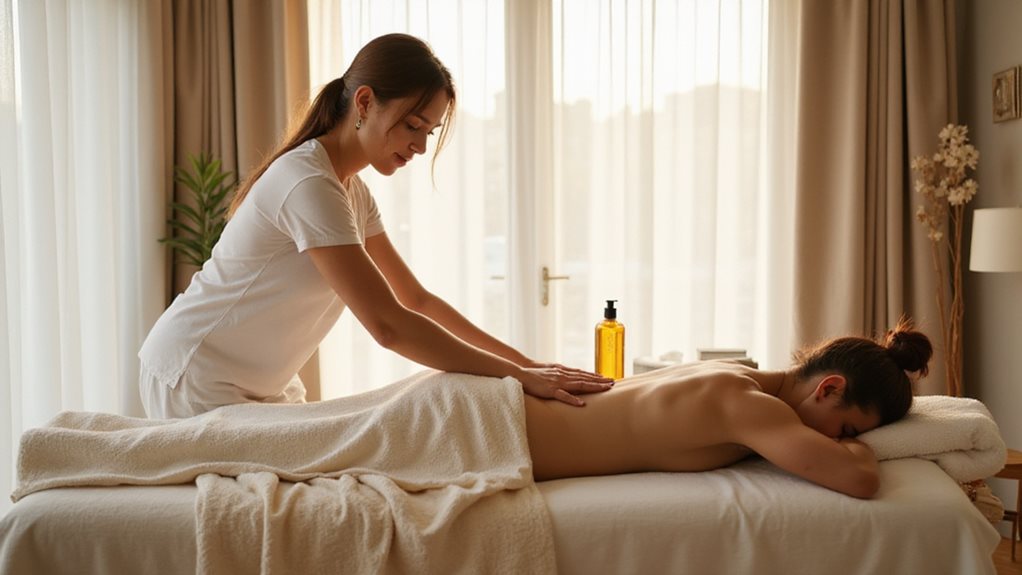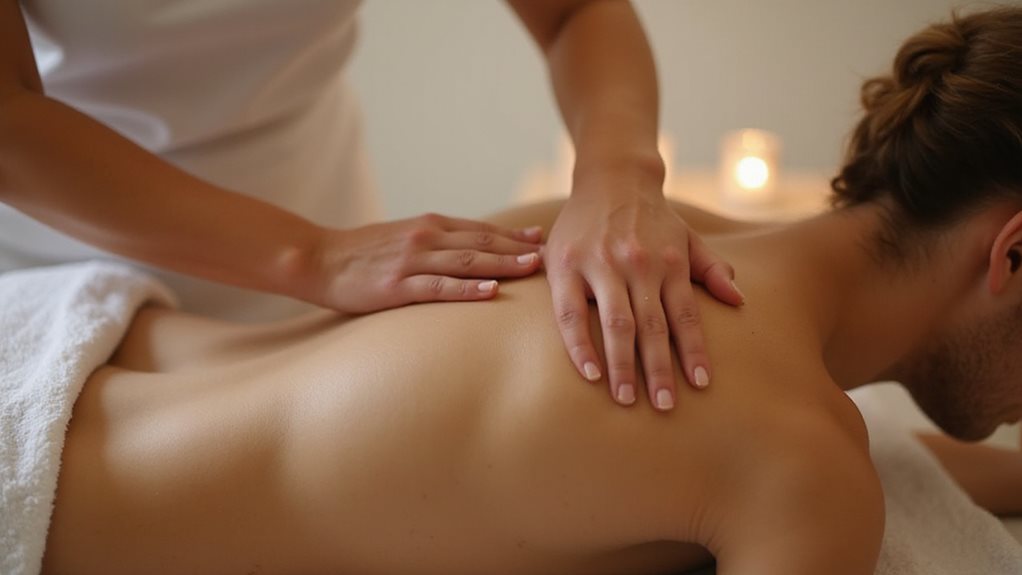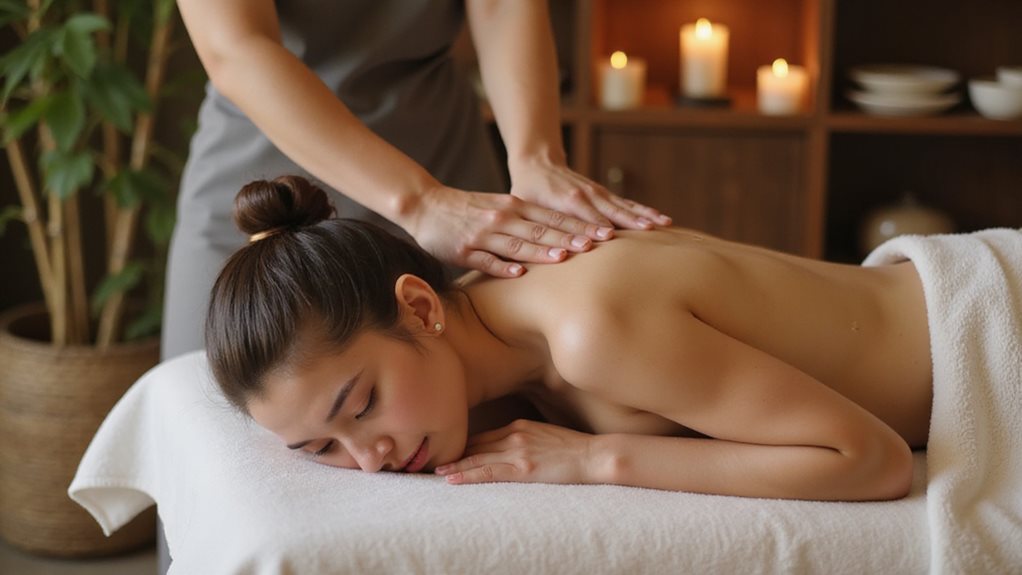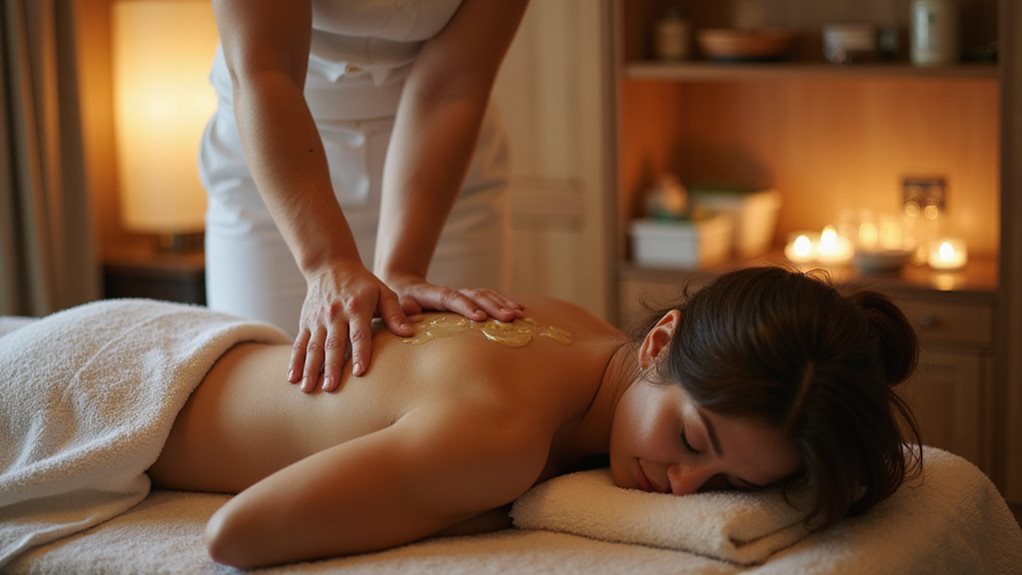Swedish massage techniques help people feel better in both body and mind. As a massage therapist, I use smooth, gentle strokes called effleurage to warm up the muscles and help blood flow. Then, I use kneading moves called petrissage to ease tight spots and help the muscles relax even more.
These Swedish massage techniques don’t just make sore muscles feel good—they also calm your mind. Many people feel less stressed and more peaceful after a session. It’s a simple but powerful way to take care of yourself, especially if you’re feeling tense or tired.
Massage also helps improve circulation, which means your body can heal faster. If you’re curious about how massage can help you feel better every day, I’d love for you to learn more. There’s a lot to discover, and I’m here to help!
Key Takeaways
- Swedish massage uses effleurage, petrissage, tapotement, friction, and vibration for relaxation.
- Effleurage and petrissage relieve tension and release muscle knots effectively.
- It reduces stress by lowering cortisol and boosting serotonin levels.
- Enhances mobility by improving circulation and reducing joint pain.
- Promotes holistic well-being with better sleep and immune function.
Exploring Swedish Massage Techniques
While many massage modalities exist, Swedish massage stands out for its foundational techniques that prioritize relaxation and holistic well-being. Its core Swedish massage benefits and techniques offer a nurturing experience, welcoming people into a space of comfort and care. Effleurage, with its gliding strokes, warms tissues and eases tension, while petrissage kneads deeper muscles to release knots.
Tapotement’s gentle percussion stimulates nerves, and friction targets specific pain points with precision. Vibration, through rhythmic shaking, profoundly calms the body. Each method flows seamlessly, crafted to soothe both body and mind.
For anyone seeking a sense of connection and renewal, these techniques provide a shared path toward wellness, ensuring every touch resonates with empathy and understanding within a supportive community. Originating from Henrik Ling’s innovative work in Stockholm, Swedish massage has evolved into a cornerstone of modern therapy, blending ancient wisdom with physiological insight.
Key Advantages of Swedish Massage

Swedish massage offers notable benefits for stress relief. Its gentle, rhythmic techniques effectively lower anxiety levels and foster a sense of calm. It also improves physical mobility by alleviating muscle tension and breaking down scar tissue, which supports improved range of motion. Additionally, research suggests that Swedish massage may provide temporary pain relief for various conditions, contributing to overall comfort.
These combined advantages highlight why this therapy remains a valued approach for both mental and physical well-being.
Stress Relief Benefits
As stress continues to impact countless people in modern life, Swedish massage emerges as a powerful tool for relief, offering a range of physiological and psychological benefits. During sessions, it lowers pulse rate, respiratory rate, and blood pressure while reducing cortisol levels through parasympathetic stimulation, fostering deep relaxation. Hormonally, it activates serotonin and dopamine pathways, enhancing mood and curbing stress-related adrenaline.
Neurologically, it counters fight-or-flight responses, elevates vagal tone, and supports better sleep through hormonal balance. Clinical studies, including those from Cedars-Sinai/UCLA, confirm lower blood pressure and fewer stress symptoms post-session. Additionally, Swedish massage promotes improved circulation, which enhances overall relaxation and aids in muscle recovery.
For those seeking connection and calm, regular Swedish massage, guided by licensed therapists, offers a nurturing path to sustained well-being and resilience against life’s pressures.
Enhanced Physical Mobility
Uncover the life-changing power of Swedish massage in improving physical mobility, a critical aspect of overall well-being. This therapeutic practice enhances joint and muscle function, reducing pain from conditions like knee arthritis and chronic lower back issues, while promoting a greater range of motion. It increases circulation, delivering crucial nutrients to muscles and aiding in the removal of metabolic waste, which supports faster post-exercise recovery and reduces soreness.
For varied groups, from adolescents to older people, Swedish massage improves gait, balance, and joint mobility, alleviating age-related stiffness and maintaining functional independence. Relaxing tightened muscles and decreasing inflammation enable people to move freely, fostering a sense of connection and energy within their community. Research from Duke Health on knee osteoarthritis patients has shown that Swedish massage significantly improves pain and mobility after just eight weeks of weekly sessions.
Step-by-Step Guide to a Session

Many people seeking relaxation or relief from tension can benefit from understanding the structured flow of a Swedish massage session. This process, designed for comfort and efficacy, begins with a client consultation to identify needs. This is followed by a calming environment with dim lighting and soothing aromas.
The therapist starts with effleurage to warm muscles, progresses to deeper techniques like petrissage, and concludes with vibration for lasting relaxation.
Additionally, the sequence ensures a gradual increase in pressure to effectively release muscle tension.
Here’s a glimpse of the session flow:
| Step | Focus |
|---|---|
| Consultation | Identify tension areas |
| Environment Setup | Dim lights, soothing sounds |
| Core Techniques | Effleurage to vibration |
| Cool-Down | Final strokes for completion |
This structured approach guarantees everyone feels cared for and connected during their path to wellness.
Tips for Effective Pressure Application

When mastering pressure techniques in Swedish massage, therapists must carefully calibrate their touch to match the client’s comfort and therapeutic needs, ensuring a balance between effectiveness and safety. Special attention should be given to avoiding sensitive areas such as bony prominences or regions with heightened tenderness, where excessive force could cause discomfort or injury. By honing this skill, practitioners can foster trust and deliver a customized experience that promotes relaxation and healing.
Additionally, therapists should gradually increase pressure with each stroke, as seen in effleurage, to ensure a smooth transition and avoid startling the client with sudden intensity.
Mastering Pressure Techniques
Investigate the art of mastering pressure techniques, a cornerstone of effective Swedish massage that requires both skill and sensitivity. Practitioners must adeptly use strokes like effleurage for gentle warm-up, petrissage for deeper muscle work, and friction for targeted tension relief. Starting with light pressure soothes the nervous system, while gradual progression to firmer force guarantees comfort.
Monitoring client feedback through verbal cues and body language allows for tailored adjustments, balancing intensity with calming effleurage. Precision is key—firm pressure suits large muscle groups, while a lighter touch protects joints. Therapeutic oils improve smooth shifts, supporting varied pressure application.
This thoughtful approach fosters trust and connection, inviting clients into a shared expedition of relaxation and healing through skilled, empathetic touch. Understanding the distinct purposes of each stroke, such as tapotement for nervous system stimulation, enhances the ability to apply pressure effectively during a session.
Avoiding Sensitive Areas
A critical aspect of Swedish massage is the careful navigation of sensitive areas to guarantee client safety and comfort. Therapists must avoid high-risk zones like genital regions, nipples, and abdominal viscera, where heavy pressure risks organ strain or ethical breaches. Light, noninvasive strokes are advised for areas like breast tissue or pectoral regions, while gentle, epigastric strokes suit abdominal zones.
Caution is crucial near the xiphoid, ribs, and axillary lymph nodes to prevent fractures or lymphatic disruption. Additionally, therapists should be mindful of areas of caution, such as the popliteal fossa, to avoid injury to underlying structures like the popliteal artery.
Pre-session communication and authentic-time feedback guarantee client autonomy, with verbal and written consent mandatory for sensitive treatments. Draping protocols and pain-scale checks foster trust, while cultural sensitivity respects personal needs, creating a safe, inclusive space for all.
Holistic Wellness Through Massage

As people seek thorough approaches to health, Swedish massage emerges as a powerful tool for holistic wellness, addressing not just physical ailments but also mental and emotional well-being. It improves circulation, reduces muscle tension, and alleviates chronic pain, fostering physical vitality. Simultaneously, it nurtures the mind by lowering stress by 65%, elevating serotonin and dopamine for emotional balance, and easing anxiety across diverse groups.
Beyond this, Swedish massage supports better sleep, improves mental clarity, and strengthens immune responses through natural killer cell augmentation and lymphatic efficiency. Research also shows that it can significantly decrease cortisol levels, contributing to reduced stress and enhanced relaxation. For special populations, it offers prenatal depression relief and autism support via sensory integration.
This inclusive therapy unites body and spirit, inviting everyone into a shared experience of renewed health and connection.
Important Safety Considerations
People embracing the holistic benefits of Swedish massage must also recognize the importance of safety to guarantee a positive experience. Certain conditions, such as open wounds, recent surgeries, or active skin issues like eczema, contraindicate massage to prevent harm. Systemic health concerns, including blood clots or cardiovascular problems, require medical clearance and tailored approaches.
Therapists must prioritize hygiene by sanitizing equipment and monitoring client feedback for discomfort or adverse reactions. Clients, in turn, should communicate medical histories, pregnancy, or ongoing treatments like chemotherapy to ascertain safe sessions. Consulting healthcare providers for chronic conditions or uncertainties fosters a secure environment.
Additionally, therapists should conduct a thorough health history assessment to identify any potential contraindications before beginning a session. Together, these precautions create a nurturing space where everyone in the massage community can thrive with confidence and care.
Frequently Asked Questions
What Are the Main Benefits of Swedish Massage Techniques?
Swedish massage techniques help relax tight muscles, improve blood flow, and reduce everyday stress. They also support mental clarity and leave you feeling calm and refreshed.
How Long Does a Swedish Massage Session Last?
A Swedish massage session typically lasts 60 to 90 minutes, depending on personal needs and goals. Therapists tailor durations to guarantee comfort, address tension, and foster relaxation for each client’s distinct experience.
Can Swedish Massage Help With Chronic Pain?
Chronic pain can be a persistent challenge, but relief is possible. Evidence shows specific massage approaches effectively reduce pain, improve function, and support long-term well-being, offering a hopeful path for those seeking comfort.
Is Swedish Massage Suitable for Pregnant Women?
Serenity versus strain: Swedish massage offers pregnant women a gentle escape from physical discomfort. With tailored care, it safely eases aches and stress, fostering well-being. Always consult professionals to guarantee a nurturing, supportive experience.
What Should I Wear During a Massage?
When considering attire for a massage, one should prioritize comfort and communicate preferences with the therapist. Opt for minimal clothing or use provided draping for modesty, ensuring ease of access for effective treatment.
How Often Should I Get a Swedish Massage?
In the calm of routine versus the storm of stress, one wonders how often to seek relief. Experts suggest monthly sessions for maintenance, increasing to weekly for intense needs, always guided by individual wellness goals.
Conclusion
Swedish massage techniques do more than feel good—they help your body and mind work better together. I’ve seen people walk in feeling tense and leave with a smile, their shoulders relaxed and stress lifted. With moves like effleurage and petrissage, your muscles loosen and your body starts to heal.
These Swedish massage techniques also calm your thoughts. Many of my clients say they sleep better, feel more focused, and worry less after regular sessions. It’s like giving your whole self a fresh start, not just your muscles.
If you’re looking for a simple way to feel better every day, massage is a great place to start. I’m here to guide you and answer questions. Let’s explore how massage can help you feel your best—your journey to wellness begins now.

